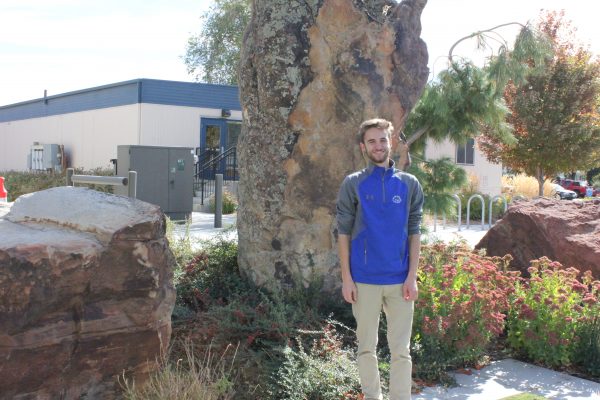Undergraduate Research Assistant
Micron School of Materials Science & Engineering

Jesse grew up in Boise, graduating from Boise High in 2016. He began working in the Surface Science Lab (SSL) as a volunteer researcher the summer after his junior year in high school, and continued throughout his senior year and the following summer. Jesse now attends Boise State, where he is pursuing a B.S. in Materials Science while continuing to work in the Surface Science Lab, training undergraduate and graduate student SSL users on the lab’s suite of atomic force microscopes (AFMs). He is also mentoring the lab’s newest member, volunteer research assistant Sam Ryan of Bishop Kelly High School.
During his first year in the lab, Jesse developed several electrical scanning probe microscopy (SPM) techniques for use on the SSL’s Dimension 3100 AFM. He gained experience in tunneling (TUNA), conductive (CAFM), electrostatic force (EFM), and Kelvin probe force (KPFM) microscopies. Jesse subsequently worked with graduate student Lance Patten on bringing scanning capacitance microscopy (SCM) capabilities to the SSL as well. Since then Jesse has applied these methods to study the thickness-dependent electrical and electrochemical properties of thin layer coatings of alumina (aluminum oxide, Al2O3) and titania (titanium oxide, TiO2) deposited on AZ31B (a commercially available magnesium alloy) using atomic layer deposition (ALD). The goal of this project is to investigate the feasibility of using such thin layer (few to hundreds of nanometers thick) conformal coatings to impart improved corrosion resistance to AZ31B and other strong, lightweight magnesium based alloys of interest to the aerospace industry.
In addition to hard materials, Jesse is also beginning to develop expertise in fluid imaging of soft biomaterials, including DNA, proteins, lipid bilayers, and live cells. He will be applying these skills to characterize DNA origami structures, study pore forming proteins such as cholera toxin, and investigate the interplay between external mechanical stimuli and cell stiffness.
Instruments and Techniques
- Atomic Force and Surface Probe Microscopy (AFM/SPM)
- Topography and Surface Roughness Analysis
- Noncontact
- PeakForce
- Tapping
- Electrical Characterization
- Conductive and Tunneling AFM (CAFM/TUNA)
- Electric and Kelvin Probe Force Microscopy (EFM/KPFM)
- Fluid Imaging
- Topography and Surface Roughness Analysis
- Scanning Electron Microscopy (SEM)
Publications
Peer Reviewed Journal Publications
- J. Newberg, J. Schimpf, K. Woods, S. Loisate, P. H. Davis, and G. Uzer, “Isolated nuclei stiffen in response to low intensity vibration” J. Biomech. 111: 110012 (2020). https://doi.org/10.1016/j.jbiomech.2020.110012
- C. Hollar, Z. Lin, M. Kongara, T. Varghese, C. Karthik, J. Schimpf, J. Eixenberger, P. H. Davis, Y. Wu, X. Duan, Y. Zhang, and D. Estrada, “High-Performance Flexible Bismuth Telluride Thin Film from Solution Processed Colloidal Nanoplates” Adv. Mater. Technol. 5: 2000600 (2020). https://doi.org/10.1002/admt.202000600
- P. Barnes, A. Savva, K. Dixon, H. Bull, L. Rill, D. Karsann, S. Croft, J. Schimpf, and H. Xiong, “Electropolishing valve metals with a sulfuric acid-methanol electrolyte at low temperature” Surf. Coat. Tech. 347: 150-156 (2018). https://doi.org/10.1016/j.surfcoat.2018.04.082